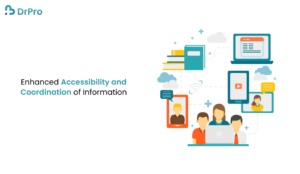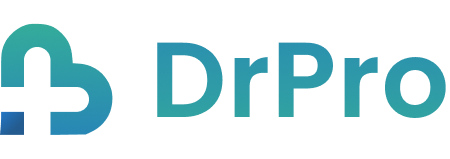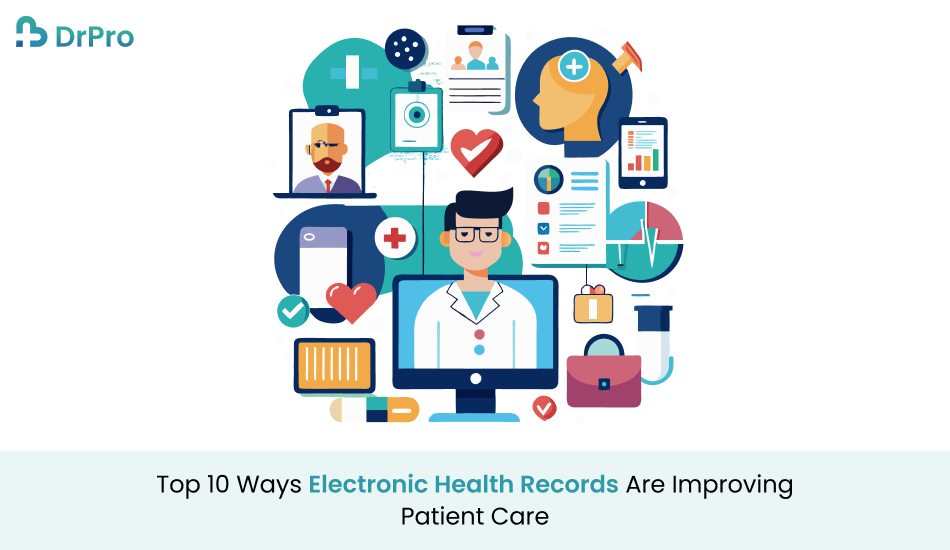Quick Summary
There are various ways in which Electronic Health Records (EHRs) are changing patient care. They enhance patient safety and security through robust data protection measures, while also enabling invaluable research while keeping the data anonymous.
EHRs can prevent medical errors and side effects by providing quick and easy access to easy-to-understand patient histories, which is especially important in times of emergencies. They simplify healthcare workflows, improve chronic disease management, and facilitate data analysis for medical research.
Electronic Health Records also empower patients by providing them access to their health information and educational resources like blogs, articles, etc. These systems also increase overall healthcare efficiency, potentially reducing costs, and offer enhanced flexibility through cloud-based solutions.
Introduction
Healthcare today is much different with the help of EHRs. They are fundamentally transforming how users of medical services organize and exploit confidential information about patients. A myriad of advantages come from these computerized means that entirely enhance health care outcomes due to the replacement of conventional paperwork and physical records.
EHRs could transform the medical field. The top 10 ways that electronic health records are changing patient care are looked at in this blog post. We will talk about the ways they impact patient outcomes and how they impact healthcare delivery systems. We will also talk about how medical staff views patient care and their professional roles.
Enhanced Patient Safety and Security:
EHRs have become important in improving patient security and safety. To maintain patient privacy from unimportant access to sensitive information, they use strong systems for encryption and follow strict rules such as HIPAA, and others. In addition, Electronic Health Records ensure data anonymity by allowing for the aggregation of huge datasets, which is very useful in the conduct of public health studies during outbreaks without compromising on individual patient confidentiality.
Data Encryption and Privacy:
About the privacy of patient data, EHRs use the highest encryption to ensure that it is not accessed by anyone unauthorized to do so. It also enables an organization to meet security and privacy regulation standards in society such as the Health Information Portability and Accountability Act or HIPAA to protect patient’s health information.
Access Controls:
The application of access control by different roles helps in a way of preventing people from gaining access to the patient record.
Anonymized Data for Research:
This was spoken to by the capacity to gather EHR data at a vast scale and aggregate them such that patient information is anonymized to allow for population-level studies.
Prevention of Side Effects and Medical Errors:
Quick access to comprehensive patient data histories within Electronic Health Records is crucial to prevent different side effects caused by various medicines that may result in medical errors. Especially in emergency cases where lives are at stake, it becomes essential to know patient’s allergies, current medications they are using, and past treatments that they underwent to save their lives through this kind of system. Additionally, it helps practitioners keep track of long-term trends hence making more educated decisions related to therapy which are also safe.
Allergy Alerts:
What would take doctors days to notice, EHRs can quickly flag if the prescribed medication has any allergens that the patient is allergic to to save the patient a trip back to the hospital to die from an allergic reaction.
Drug Interaction Checks:
Electronic Health Records assess the compatibility of the prescribed medications that may harm the patient in case taken together.
Access to Complete Patient History:
In emergencies, identification data such as prior surgeries, current therapy, and current medications or drugs can be obtained by a physician much faster.
Enhanced Accessibility and Coordination of Information

Electronic Health Records dramatically transform the access to patients’ data by any medical practitioners – from their primary physicians down to specialized ones. This easy flow of data guarantees that all clinical staff looking after an individual are equipped with the same latest information concerning him/her. This removes the necessity for patients to carry their health records each time. Because of this, it will decrease the chances of errors in communication between specialists and improve continuity in providing care for them.
Real-Time Data Sharing:
EHRs make the data flow between the healthcare providers, primary care, and specialists, with updated information available to all viable healthcare clinicians.
Reduction in Redundancy:
We cannot bring along paper files and have documents with a medical history which makes one confused.
Care Coordination:
They are agreed to enable the integration of care across various specialists to enhance the improve the quality of the care because it enables everyone involved in the care of the client to be in a position to know the progress of care being administered to the client.
Improved Long-Term Management
EHRs serve an important part in the management of long-term conditions, such as diabetes, by providing detailed reminders about treatment regimens all through time.
The reminders ensure that the caregivers get indications that the process will be implemented soon, and give change in prescriptions or possible effects according to information stored electronically about the patient. This way is seen as more effective when it comes to managing such diseases thereby promoting the general well-being of people who have them.
Tracking Health Metrics:
EHRS serves as a record of the patient’s growth over the life of the record including blood pressure, blood sugar, and cholesterol among others that will facilitate better treatment plans in the long run.
Automated Reminders:
The EHR provides notifications whenever there are pending lab tests, time for the next refill of the medications prescribed, and the next date that the patient is due for the next appointment.
Personalized Treatment Plans:
Using patient’s records of past ailments and current vital signs, EHRs can help devise customized treatment approaches that enhance positive outcomes for long-term diseases such as diabetes, hypertension, and asthma.
Simplified Workflow
EHRs streamline administrative tasks, significantly simplifying the workflow in healthcare settings. EHR Systems reduce paperwork and human data entry by digitizing patient records, prescription management, and appointment scheduling. Healthcare personnel can spend more time caring about patients and less time on administrative duties because of this efficiency, which at some point improves the general level of care delivered.
Automated Data Entry:
Compared to traditional paper records EHRs automatically document patient information which distills time and practically eliminates the risk of mistakes.
Efficient Prescription Management:
Through writing a prescription, doctors can make use of the electronic touch-tone, making prescriptions to reach pharmacies and in the process reducing redundant time and minimizing errors that may exist when making medication orders.
Integrated Scheduling Systems:
Usually, EHR systems have incorporated schedule programs to enable effective organization of appointments, making such extra management systems unnecessary as they improve organizational effectiveness
Sharper Research and Medical Analysis
Electronic health records are digital which aids in better data analysis and research quality improvement in hospitals and other healthcare establishments. They can simplify aggregation and analysis of massive amounts of information from EHRs leading to understanding trends about population health, as well as effectiveness of treatment among others such as where or how else care may require further development within its provision framework hence making them very useful for these purposes.
Hence by adopting such an approach as evidence-based decision making one would be able to develop their career concerning medicine considerably faster than they would otherwise be able to.
Population Health Analytics:
These causes can be tracked from the EHR data by aggregators and help in the observation of disease prevalence, vaccinations, and other threats within different populace.
Outcome-Based Studies:
It enables the researchers to examine the efficacy of the treatments offered by offering results from other groups and enhance medical practice.
Big Data for Personalized Medicine:
Consequently, EHR information can help in the generation of treatment models that will inform treatment options based on genetics, lifestyle, and environment.
Enhanced Management of Preventable Diseases
Early detection and management of preventable diseases are significantly aided by EHRs in patients. Through monitoring the patient’s health metrics throughout time, subtle changes or risk factors can be identified by these systems that would have been unnoticed otherwise. Healthcare providers are therefore able to intervene earlier to prevent any onset or worsening of several diseases using this kind of alert system.
Risk Factor Identification:
Patient health information stored in EHR systems can help raise the alarm if there are such potential biomarkers of several preventable diseases including heart disease and diabetes through continuous monitoring of the patient’s lifestyle and health status.
Preventive Care Alerts:
They also give health care providers and patients schedule alerts on various vaccinations, screening, and routine tests that can help to identify problems before they worsen.
Patient-Specific Health Recommendations:
Since EHR has the capability of analyzing data at a patient level, it can provide unique health advice for changes in diets, exercise, and modifications to drugs.
Enhanced Patient Engagement and Individual Empowerment
Electronic Health Records empower individuals with better access to health information. Most EHR systems have patient portals for viewing laboratory results, asking for medication refills and even emailing doctors. This openness doesn’t just boost patient involvement; it also helps patients adhere more closely to their prescribed therapy regimens as well as other aspects of care coordination. What’s more, these tools frequently offer links to relevant information that adds value for patients.
Patient Portals:
Today most EHR systems include patient portals whereby people can get access to their records, results of tests, and even talk to caregivers.
Educational Resources:
Patients are also able to read articles, watch videos, or blogs about their health conditions concerning their EHR making better decisions.
Enhanced Compliance:
Patients who get to see their records and especially care plans that have been prepared for them act as reminders to conform to treatment plans and appointments for review.
Increased Efficiency and Cost-Effectiveness
Healthcare delivery has become more efficient and cheaper since the implementation of EHRs. It is not paper-based however, their implementation can drastically reduce the expenses connected with physical storage capacity as well as manual record-keeping. If the diagnosis is rightly done then treatment planning will be right thus saving on resources otherwise wasted while handling many people within the health sector. A possible result is the lower cost of going for medical checks hence increased chances that the majority will access them in various clinics which lowers their prices at times.
Reduction in Paperwork:
EHRs relieve the burden of paperwork which comes with the need to write, store, and organize physical papers.
Reduced Medical Errors:
Less document submission mistakes and fewer wrongly written prescriptions mean that health problems and their interventions reflect the actual situation, and that continuously saves money on care.
Faster Billing Processes:
Ehr’s help in billing and insurance claims which helps in reducing and minimizing revenue cycles of the healthcare providers.
Cloud-Based EHR Systems for Enhanced Flexibility
Compared to traditional in-house physical servers and IT infrastructure, DrPro‘s EHR systems on the cloud are more flexible scalable, and less expensive. Healthcare providers always have the most updated instruments because they can easily upgrade and get them in different places. The need for huge IT support within premises is also cut down through the use of cloud-based systems in healthcare institutions which could lead to reduced operational costs.
Remote Access:
The implementation of cloud-based EHRs means they can be accessed from any geographic location and availability makes it possible for a provider to offer telemedicine services and also review the records away from the office.
Scalability:
Cloud-based IT systems allow volume expansion as per growing requirements in healthcare organizations and still do not require the same amount of IT infrastructure investment that on-site options do.
Automatic Updates:
Cloud-based EHRs update their software frequently and consequently, the practitioners can have access to information within the Electronic Health Records without having to rely on the IT department.
Conclusion
The use of electronic health records has changed the management and delivery of healthcare, having an important effect on patient care. Electronic Health Records electronics have become important in today’s healthcare due to their capacity to improve patient safety, improve management of care, increase efficiency, and provide better tools for treatment and diagnosis. They improve public health reporting, promote long-term illness management, and give patients peace of mind to take an active role in their health. In addition, Electronic Health Records data and analytics features help doctors and medical professionals make more accurate decisions.
The collaboration between ProjectTree and DrPro ensures a comprehensive approach to managing projects and healthcare systems, optimizing both processes.
FAQs
1. What are the main benefits of Electronic Health records for patients?
Electronic Health Records improve patient safety, and care coordination, and empower patients by providing easy access to their health data. They also help manage chronic conditions more effectively.
2. How do Electronic Health Records prevent medical errors?
Electronic Health Records alert providers to drug interactions, allergies, and other risks, while giving instant access to comprehensive patient histories, helping avoid mistakes in treatment.
3. Can Electronic Health Records be accessed by multiple healthcare providers?
Yes, Electronic Health Records allow authorized healthcare providers to access the same up-to-date patient information, ensuring better communication and continuity of care.
4. How do Electronic Health Records improve the management of chronic diseases?
Electronic Health Records track long-term health metrics, generate reminders for medications and appointments, and allow doctors to adjust treatment plans based on real-time data.
5. What role do patients play in Electronic Health Records systems?
Patients can access their records, view test results, refill prescriptions, and communicate with doctors via Electronic Health Records patient portals, empowering them to manage their health.


